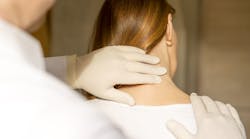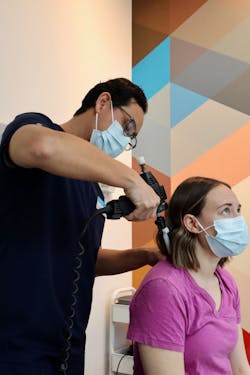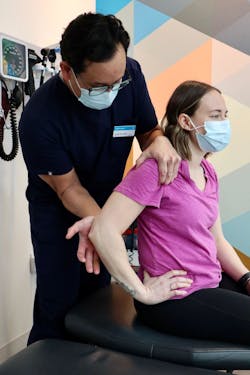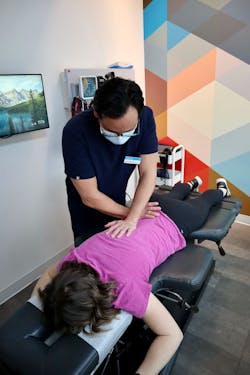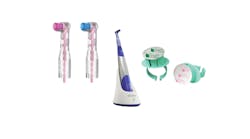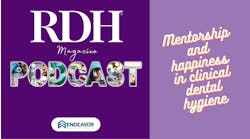Submitted by Miranda Cooper, BSDH(c), Megan Hess, BSDH(c), Morgan Slippy, BSDH(c), and Lesley Harbison, MS, RDH, EPDH.
Do you remember when you applied to dental hygiene school and how excited you were picturing your future in colorful scrubs, visiting with patients, and helping create healthy smiles? Little did you know your body was about to shout “Surprise!” as you experienced recurring aches and pains. Dental hygiene, though an amazing career, can take a toll on your body. Aches and pains may eventually affect many dental hygienists, but fortunately there are solutions and preventive steps that may help.
What are those aches and pains? They’re musculoskeletal disorders (MSDs), which typically arise from someone’s professional occupation. Careers with repetitive movements and static, awkward positions contribute to MSDs.1 In general, the most common sites for MSDs in dental professionals are the neck, shoulders, wrists, hands, and back.2
Carpal tunnel syndrome (CTS) is an extremely common MSD that’s frequently diagnosed in dental professionals. In fact, the dental workforce is 10 times more likely to develop CTS than any other professional workforce in the United States.3
Related reading
Nearly 100% of hygienists have pain on the job. What can you do?
Hygiene instrumentation, hand health, and ergonomic harmony
As new graduates, we wanted to understand more about what causes MSDs and their associated risk factors to help prevent these in our own careers. The risk factors fall into three categories: biomechanical, environmental, and psychosocial.3
Biomechanical risk factors include the daily mechanical movements and forces used to perform tasks such as using hand scalers and ultrasonic scalers.3 According to Blake McGowan, repetitive tasks, excessive force, awkward positions, prolonged sitting and standing, and static postures are the primary biomechanical risk factors for MSDs among dental hygienists.4
Environmental factors involve how the working environment can impact the body.3 One new environmental factor that can increase the chance of a chronic MSD is the onset of the SARS-Cov-2 pandemic. The use of additional personal protective equipment (PPE) has increased our mental stress and reduced the freedom of movement we enjoyed before the pandemic.5 Things that can improve our working environment include having a good clinician chair and adequate lighting to see inside the oral cavity.3,5
The psychosocial risk factors are those that might impact our feelings and emotions, such as the long hours and heavy patient load.3
Modalities to relieve pain
In addition to practicing good ergonomics and improving the working environment, we explored therapeutic modalities to relieve pain and prevent long-term issues associated with MSDs. Chiropractic care was of particular interest to us. Doctors of Chiropractic (DC) are health-care providers who focus primarily on the musculoskeletal system and how it relates to the nervous system.6
The American Chiropractic Association (ACA) estimates that 35 million Americans seek care from a DC yearly.6 One of the most common therapeutic approaches used by chiropractors is spinal manipulation or adjustments. According to Craig Gonzales, DC, one of the chiropractors we interviewed, manipulation is defined as adjusting the joints and spine back to their original form and function through controlled force. This can be accomplished manually or with an instrument-assisted technique.6 Through various chiropractic adjustments, patients experience reduced pain, increased movement, and improved performance.
Since dental hygienists are at greater risk for chronic pain and MSDs due to the repetitive nature of their job, chiropractic care is one of many treatment options they can pursue for relief. Chiropractors can help hygienists understand why they are experiencing pain and what can be done to prevent it. This may include changing posture, stretching in between patients, and exercising regularly. Using joint manipulation modalities, chiropractors can also treat the flareups that may occur during a dental hygienist’s career.
What did we learn from our interviews?
Due to the limited research regarding the benefits of chiropractic care for dental hygienists, we conducted interviews with chiropractors and experienced hygienists who have received or currently receive chiropractic care. We wanted to gain a better understanding of the benefits of chiropractic care, understand why dental hygienists seek chiropractic care, and identify barriers to receiving chiropractic care.
We asked several hygienists about their experiences with MSDs and chiropractic care. One has been receiving chiropractic care since 2008 due to CTS and other musculoskeletal problems. She said, “After a few chiropractic adjustments, I really did feel better. I definitely feel less pain.”
Another has sought chiropractic care ever since dental hygiene school, but she says she doesn’t go often enough. When she is consistent with treatment, it prolongs the time between her aches and pains.
Another one reported that though she has received treatment from a chiropractor, she prefers physical therapy because she believes it’s more long-term. Interestingly, both chiropractors we interviewed supported this idea, promoting physical therapy as an adjunct for chiropractic care to aid in a long-term impact. The chiropractors also emphasized incorporating a few stretches that relate to dental hygienists’ specific job functions, saying this could do a lot to reduce pain.
We asked two chiropractors about their experiences treating hygienists. We asked one about the common areas he adjusts when treating hygienists. He said rib displacement, tight pectoralis muscles, tight trapezius muscles, tight levator scapulae muscles, and a significant amount of mobility restriction in the upper ribs and back. Figure 1 shows a chiropractor adjusting a displaced first rib into place to restore normal function and range of motion. Figure 2 shows manipulation of the rotator cuff, while figure 3 shows spinal manipulation of the lower back.
There are several philosophies practiced by today’s chiropractors. Our research and interviews found a commonality in approaching MSDs with the goal of improving the condition while reducing the frequency of needed care.6 One chiropractor said, “I treat acute injuries primarily, with the goal of the patient getting better and not having to keep coming back. I teach patients some simple things they can do at home to prevent injuries from recurring.”
Why not chiropractic care?
After conducting our interviews and reviewing the literature, it’s clear that chiropractic treatments have benefits for dental hygienists and may increase career longevity. We wanted to understand why dental hygienists may be hesitant to try it. The most common barrier mentioned was the fear of manipulation and the potential of having to continue treatments for an extended period.
One hygienist worried that the popping her back would cause more problems than help, which would lead to long-term dependence on chiropractic care. She stated that the sound of her joints popping was scary. Another hygienist advised her colleagues to “do your own research and make sure the chiropractor you choose is a good one.”
In particular, fear of neck manipulation may cause some people not to consider chiropractic care. The ACA states that neck manipulation is remarkably safe. Some patients may experience soreness for up to 24 hours, but many leave with relief from their pain.6 The barrier of fear, though relatable, can be mitigated by building a trusting relationship with a chiropractor who will listen to you and understand your needs.
Another common barrier to chiropractic care is the lack of benefits for this treatment. Chiropractic care may not be perceived as necessary by insurance companies. Therefore, medical benefits offered by employers may not include coverage for this treatment.1
Chiropractic care does appear to bring relief for MSDs and may be a viable choice for many dental hygienists. Our research concluded that if dental hygienists experience MSDs, finding a trustworthy chiropractor can improve quality of life and extend career longevity.
We hope this article helps you understand your body and what a chiropractor can do to help. We also hope this helps to alleviate any anxiety that is interfering with seeking care. From our interviews, we concluded that it’s a fact! Chiropractors can help.
References
- Hawk C, Whalen W, Farabaugh RJ, et al. Best practices for chiropractic management of patients with chronic musculoskeletal pain: A clinical practice guideline. J Altern Complement Med. 2020;26(10):884-901. doi:10.1089/acm.2020.0181
- Malloy L, Boyd LD, Adams JL, Vineyard J. Quality of life in dental hygienists using complementary alternative medicine approaches for work‐related musculoskeletal disorders. Int J Dent Hyg. 2021. doi:10.1111/idh.12549
- Netanely S, Luria S, Langer D. Musculoskeletal disorders among dental hygienists and students of dental hygiene. Int J Dent Hyg. 2020;18(2):210-216. doi:10.1111/idh.12428
- McGowan B. Biomechanical risk factors for musculoskeletal disorders: What's new? EHS Today. Published online 2016. Retrieved October 10, 2020. https://www.ehstoday.com/health/article/21917752/biomechanical-risk-factors-for-musculoskeletal-disorders-whats-new
- Gandolfi MG, Zamparini F, Spinelli A, Risi A, Prati C. Musculoskeletal disorders among Italian dentists and dental hygienists. Int J Environ Res Public Health. 2021;18(5):2705. doi:10.3390/ijerph18052705
- ACA Hands Down Better–American chiropractic association. What to expect on your first visit. Accessed April 5, 2022. https://handsdownbetter.org/about-chiropractic/what-to-expect-on-your-first-visit/
